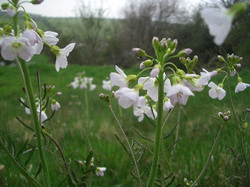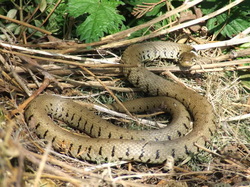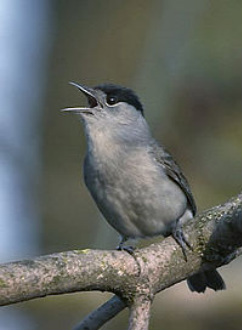20th April 2011 - Over Brickfields this morning for a couple of hours, undertaking some practical work, putting more mulching down and around the newly planted Trees. I was helping out the council's environmential wildlife team led by Benjamin Sanderson. Cranham Cllr. Gillian Ford ( Ratepayers Association) was helping as a volunteer as well. I don't think my feedback at the local Ratepayers meeting prompted her to do it as I know she has been involved over there before it was designated a Nature Reserve. Good on yer Gillian !
We had finished about 1:00pm and had a look around the reserve....It's looking good, plenty of bird song and another bird for the list a Blackcap. Plants are flowering see picture below of the Lady's Smock. But due to the very warm weather,everything is awake now and that included a rather large Grass snake swimming in the Pond.
Up to date now, phew ! see you soon.
We had finished about 1:00pm and had a look around the reserve....It's looking good, plenty of bird song and another bird for the list a Blackcap. Plants are flowering see picture below of the Lady's Smock. But due to the very warm weather,everything is awake now and that included a rather large Grass snake swimming in the Pond.
Up to date now, phew ! see you soon.

Lady's Smock or Cuckoo Flower (Cardamine pratensis) is a flowering plant It is a food plant for the orange tip butterfly and makes a valuable addition to any garden which aims at attracting wildlife. In some European countries, including parts of Germany, the plant is now under threat. Often grows close to water and grows best in marshy soil. Ideal for Brickfields.

Grass snake - This is our biggest snake which can grow well over a metre in length. Typically this snake is grey-green in color with a distinct yellow and black collar round the neck, black bars down the side and sometimes two rows of black marks down the back. The Grass Snake is often associated with water; it swims well and feeds mainly on amphibians and fish. It is a sun loving animal and is most often encountered basking in the sun.

Blackcap (male).
A distinctive greyish warbler, the male has a black cap, and the female a chestnut one. Its delightful fluting song has earned it the name 'northern nightingale'. Although primarily a summer visitor birds from Germany and north-east Europe are increasingly spending the winter in the UK.
To see them look in woodland, parks and gardens with plenty of trees and shrubs. In winter they will readily come into gardens.
Breeding birds arrive in April and May, leaving in September and October. Some European birds winter in the UK, largely in England.
They eat Insects and berries.
A distinctive greyish warbler, the male has a black cap, and the female a chestnut one. Its delightful fluting song has earned it the name 'northern nightingale'. Although primarily a summer visitor birds from Germany and north-east Europe are increasingly spending the winter in the UK.
To see them look in woodland, parks and gardens with plenty of trees and shrubs. In winter they will readily come into gardens.
Breeding birds arrive in April and May, leaving in September and October. Some European birds winter in the UK, largely in England.
They eat Insects and berries.
 RSS Feed
RSS Feed